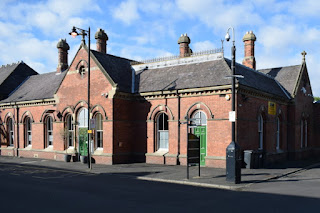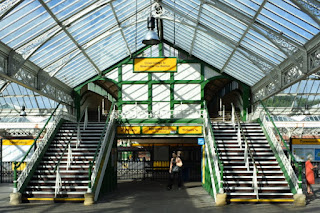Tynemouth is a Tyne and Wear Metro station, serving Tynemouth in North Tyneside. It joined the network on 11 August 1980, following the opening of the first phase of the network, between Haymarket and Tynemouth via Four Lane Ends.
History
The station was originally opened on 7 July 1882 by the North Eastern Railway. Designed by architect William Bell, the station was designated as a Grade II* listed building on 2 November 1978.
Following a significant decline in the number of passengers using the North Eastern Railway's services in North Tyneside in the early 1900s, the line was electrified as part of the Tyneside Electrics network, using a 600 V DC third-rail system.
Owing to falling passenger numbers, rising costs, and the need to renew life expired infrastructure and rolling stock, the Tyneside Electrics network was de-electrified and converted to diesel multiple unit operation in 1967.
The station has remained in constant use since opening, with British Rail continuing to use the station's former bay platforms for services from Newcastle via Wallsend until the day before the first section of the Tyne and Wear Metro opened.
Tynemouth joined the Tyne and Wear Metro network on 11 August 1980, with the opening of the first phrase of the network between Haymarket and Tynemouth via Four Lane Ends. Prior to the introduction of through services to St James via Wallsend on 14 November 1982, all trains used the present platform 2.
Regeneration
In 2007, English Heritage placed the station on their Heritage at Risk Register. The survey is used by national and local government, a wide range of individuals and heritage groups to establish the extent of risk and to help assess priorities for action and funding decisions.
Work on the £3.68 million regeneration project began in early 2011, and was completed in the following year. On 2 July 2012, the station was officially reopened by Anne, Princess Royal, and subsequently removed from the register.
Facilities
The station has two platforms, both of which have ticket machines (which accept cash, card and contactless payment), seating, next train audio and visual displays, timetable and information posters and an emergency help point.
There is step-free access to both platforms by road bridge, with platforms also linked by a pre-grouping wooden footbridge, which is similar in design to that at nearby Cullercoats.
The station has a pay and display car park, with 71 spaces. There is also cycle storage at the station, with 4 cycle pods and 5 Sheffield stands.
Tynemouth Market
A weekly market is held at the station every Saturday and Sunday, which doubles as a farmers' market once a month. The Friends of Tynemouth Station also hold book fairs several times a year at the station.
Text courtesy of Wikipedia.
5th September 2023















1st September 2022


















3rd April 2013
8th August 2012
10th August 2008
r.jpg)
r.jpg)

15th July 2008
r.jpg)
r.jpg)
r.jpg)
r.jpg)
r.jpg)
r.jpg)
r.jpg)
16th September 2007
r.jpg)
More Information:
- Wikipedia: Tynemouth Metro station
- Co-Curate: Tynemouth Station
- Historic England: Tynemouth Station and subsidiary buildings with canopies and footbridge
See my other photos around Tynemouth:
- Tynemouth
- Tynemouth Castle & Priory
- Tynemouth Seafront
- Tynemouth Watch House
- Tynemouth, Lord Collingwood Monument
- Tynemouth, North Tyne Pier & Lighthouse
- Tynemouth, R.M.S. Queen Elizabeth II
- Cullercoats
- North Shields to Tynemouth walk
- North Shields Fish Quay
- North Shields Fish Quay, Clifford's Fort
- North Shields, High & Low Lights
- North Shields, River Tyne
- North Shields, Whitehill Point, HMS Tyne












4 comments:
whenever im there, i always imagine the famlies of old travelling with their maids and bustles and very large trunks, and the poor worked to death unappreciated porters. i like 2 see what i can spot that i havnt noticed b4.
It's certainly a fascinating station, one of the finest I ever saw.
My visits there remind me of going to the seaside as a kid from Heaton station on the older trains we used to call multi's.
Post a Comment